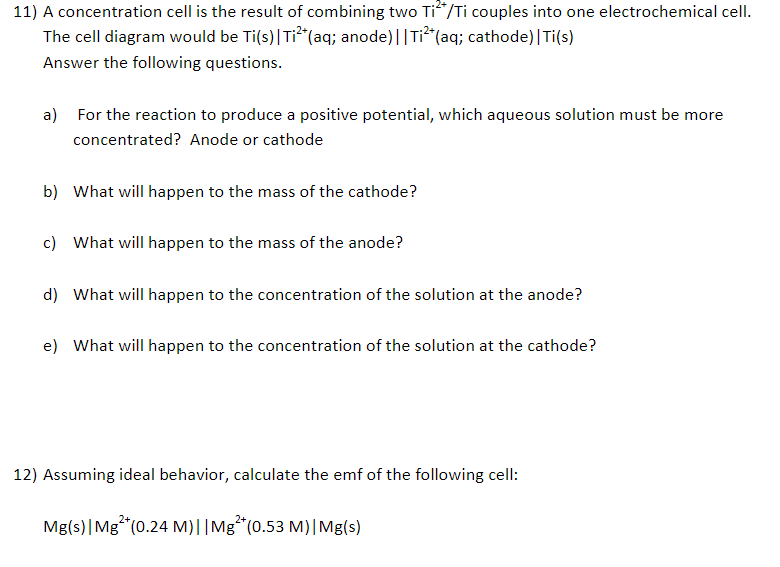11) A concentration cell is the result of combining two Ti²*/Ti couples into one electrochemical cell. The cell diagram would be Ti(s)| Ti²*(aq; anode)|| Ti²*(aq; cathode) | Ti(s) Answer the following questions. a) For the reaction to produce a positive potential, which aqueous solution must be more concentrated? Anode or cathode b) What will happen to the mass of the cathode? c) What will happen to the mass of the anode?
11) A concentration cell is the result of combining two Ti²*/Ti couples into one electrochemical cell. The cell diagram would be Ti(s)| Ti²*(aq; anode)|| Ti²*(aq; cathode) | Ti(s) Answer the following questions. a) For the reaction to produce a positive potential, which aqueous solution must be more concentrated? Anode or cathode b) What will happen to the mass of the cathode? c) What will happen to the mass of the anode?
Chemistry: The Molecular Science
5th Edition
ISBN:9781285199047
Author:John W. Moore, Conrad L. Stanitski
Publisher:John W. Moore, Conrad L. Stanitski
Chapter17: Electrochemistry And Its Applications
Section: Chapter Questions
Problem 107QRT
Related questions
Question
Give handwritten answer. ASAP..

Transcribed Image Text:11) A concentration cell is the result of combining two Ti²/Ti couples into one electrochemical cell.
The cell diagram would be Ti(s) | Ti²*(aq; anode) || Ti²*(aq; cathode) | Ti(s)
Answer the following questions.
a) For the reaction to produce a positive potential, which aqueous solution must be more
concentrated? Anode or cathode
b) What will happen to the mass of the cathode?
c) What will happen to the mass of the anode?
d) What will happen to the concentration of the solution at the anode?
e) What will happen to the concentration of the solution at the cathode?
12) Assuming ideal behavior, calculate the emf of the following cell:
Mg(s)| Mg²+ (0.24 M)||Mg²*(0.53 M) | Mg(s)
Expert Solution
This question has been solved!
Explore an expertly crafted, step-by-step solution for a thorough understanding of key concepts.
Step by step
Solved in 2 steps with 1 images

Knowledge Booster
Learn more about
Need a deep-dive on the concept behind this application? Look no further. Learn more about this topic, chemistry and related others by exploring similar questions and additional content below.Recommended textbooks for you

Chemistry: The Molecular Science
Chemistry
ISBN:
9781285199047
Author:
John W. Moore, Conrad L. Stanitski
Publisher:
Cengage Learning

Chemistry & Chemical Reactivity
Chemistry
ISBN:
9781337399074
Author:
John C. Kotz, Paul M. Treichel, John Townsend, David Treichel
Publisher:
Cengage Learning

Chemistry by OpenStax (2015-05-04)
Chemistry
ISBN:
9781938168390
Author:
Klaus Theopold, Richard H Langley, Paul Flowers, William R. Robinson, Mark Blaser
Publisher:
OpenStax

Chemistry: The Molecular Science
Chemistry
ISBN:
9781285199047
Author:
John W. Moore, Conrad L. Stanitski
Publisher:
Cengage Learning

Chemistry & Chemical Reactivity
Chemistry
ISBN:
9781337399074
Author:
John C. Kotz, Paul M. Treichel, John Townsend, David Treichel
Publisher:
Cengage Learning

Chemistry by OpenStax (2015-05-04)
Chemistry
ISBN:
9781938168390
Author:
Klaus Theopold, Richard H Langley, Paul Flowers, William R. Robinson, Mark Blaser
Publisher:
OpenStax

Chemistry
Chemistry
ISBN:
9781305957404
Author:
Steven S. Zumdahl, Susan A. Zumdahl, Donald J. DeCoste
Publisher:
Cengage Learning

Chemistry: An Atoms First Approach
Chemistry
ISBN:
9781305079243
Author:
Steven S. Zumdahl, Susan A. Zumdahl
Publisher:
Cengage Learning
